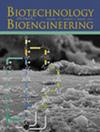Modeling the Performance of an Anaerobic Moving Bed Biofilm Reactor
Abstract
Sub-models representing transformation processes by microorganisms and hydrolases, a one-dimensional (1-D) biofilm, and a bioreactor were integrated to simulate organic-matter fermentation and methane (CH4) production in an anaerobic moving bed biofilm reactor (AnMBBR). The integrated models correctly represented all experimental observations and identified mechanisms underlying how and why AnMBBR performance changed when the volumetric loading rate (VLR) of total chemical oxygen demand (TCOD) increased from 3.9 to 19.5 kg CODT/m3-d. The fractional removal of TCOD and CH4 production decreased as the VLR of TCOD increased, in part, due to an increasing biofilm thickness that filled the protected channels in the interior of the plastic carriers and led to a decrease in biofilm surface area and an increase in the mass-transfer boundary layer. Also, the ~25-day duration for each VLR of TCOD was too brief to allow the biofilm to establish a new quasi-steady state with respect to biofilm thickness. The mechanistic understanding of how biofilm characteristics and process performance respond to increased VLR of TCOD can be applied in engineering practice to improve AnMBBR process design and operation.


 求助内容:
求助内容: 应助结果提醒方式:
应助结果提醒方式:


